24 Hours Hotline: +8613735411378
Email:chengdu@tripstoshanghai.com
24 Hours Hotline: +8613735411378
Email:chengdu@tripstoshanghai.com
"The most spectacular place I’ve ever seen." – James Cameron, director of Avatar.
Welcome to Zhangjiajie, China’s real-life "floating mountains"—a UNESCO World Heritage Site where 3,000+ quartz-sandstone pillars rise like stone giants from the mist. For photographers, this is a dreamscape of endless possibilities: towering pinnacles shrouded in clouds, deep canyons veiled in mystery, and golden sunrises that ignite the landscape.
Whether you're a landscape pro, a travel enthusiast, or an adventurer with a camera, this guide will help you capture Zhangjiajie’s magic like never before.
The Core Magic of a Photographer's Paradise
Geological Wonders: A Shooting Guide
The Science Behind the Sandstone Pillars & Best Angles
Zhangjiajie's 3000+ quartz-sandstone pinnacles were formed over 300 million years through:
Erosion: Crustal uplift + water erosion carved the vertical columns
Unique Composition: 90% quartz makes them exceptionally hard and reflective
Best Photography Techniques:
Low-Angle Shots – Shoot upward to emphasize height (16-35mm wide-angle)
Side Lighting – Morning/afternoon sun reveals dramatic textures
Aerial Perspectives – Drones showcase the forest-like density of peaks
Avatar's "Floating Mountains" (Qiankun Pillar) - Creative Approaches
This 1080m-tall pillar inspired Pandora's Hallelujah Mountains. Capture its magic with:
Forced Perspective – Position hikers on nearby paths to create "floating" illusions
Misty Backlighting – Shoot at dawn when fog diffuses the light
Moonlight Silhouettes – Long exposures under a full moon (ISO 800+, 30-sec exposure)
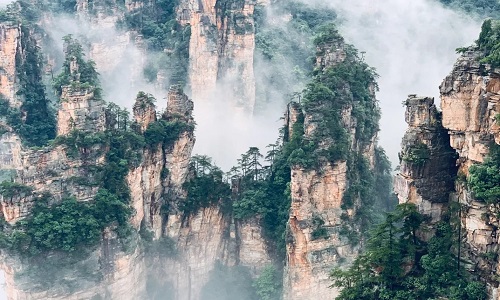
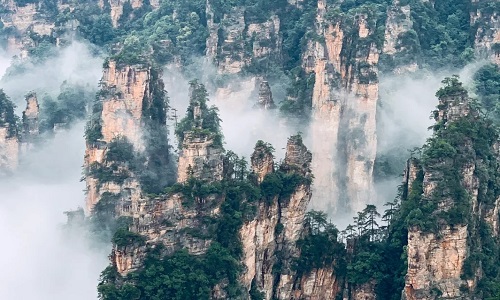
Tianmen Mountain's "Heaven's Gate" - The Sun/Moon Alignment
The 131.5m natural arch creates a rare phenomenon:
May-September: Sunrise aligns perfectly through the hole
Mid-Autumn Festival: Full moon centers in the arch at night
Pro Setup: Use a 400mm+ lens from the Tianmen Temple viewpoint (3km away)
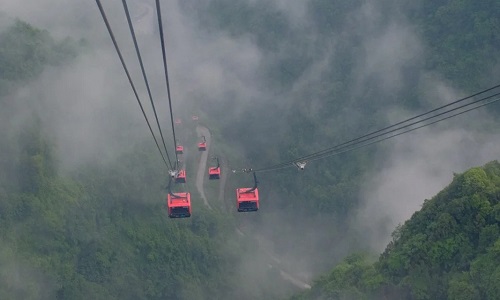
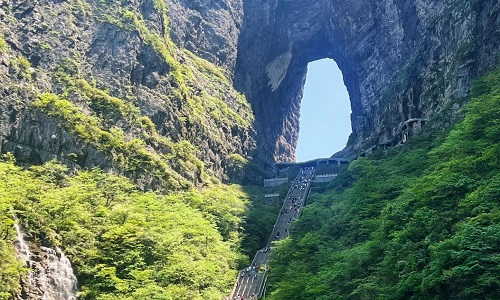
Magical Light Timetable
Pre-Dawn "Blue Hour" Cloud Seas
When: 1 hour before sunrise (4:30-5:30AM summer)
Where: Emperor's Throne (Tianzi Mountain)
Technique:
ISO 100-400 | f/8-11 | 2-5 sec exposure
Use graduated ND filters to balance bright sky/dark peaks
Focus manually on mid-distance peaks through mist
Rainy-Day Ink Wash Effect
Conditions: Light rain + 80%+ humidity
Creative Methods:
High-Key B&W – Boost contrast to mimic traditional paintings
Selective Color – Keep one peak colored in post-processing
Slow Shutter (1/4sec) – Blur moving fog for dreamy textures
"Flaming Peaks" Sunset Color Control
Golden Hour Magic:
Summer (June-Aug): Warm 3000K tones – enhance oranges
Winter (Dec-Feb): Cool 5000K backdrop – emphasize silhouettes
Advanced Tip: Bracket exposures (+/- 3EV) to blend perfect highlights/shadows
"No two days—or photos—are ever the same here." – Local Tujia photography guide
Professional Photography Guide: Mastering Zhangjiajie’s Landscapes
For photographers seeking to capture the surreal beauty of Zhangjiajie’s peaks, having the right gear and techniques is crucial. This section dives deep into equipment choices, drone regulations, tripod hacks, and secret compositions to elevate your shots from postcard-perfect to gallery-worthy.
Gear Guide: Choosing the Right Tools
1. Wide-Angle vs. Telephoto Lenses
Zhangjiajie’s towering pillars demand strategic lens selection:
Wide-Angle (16-35mm)
Best for: Immersive landscapes, foreground-background compression (e.g., cliffs with distant peaks).
Key spots:
Tianmen Mountain’s arch (emphasize the scale).
Golden Whip Stream (capture winding paths + pillars).
Tip: Use a polarizing filter to reduce haze and boost sky contrast.
Telephoto (70-200mm or 100-400mm)
Best for: Isolating individual peaks, compressing layers of misty ridges.
Key spots:
Yuanjiajie’s Avatar peaks (create "floating mountain" effects).
Tianzi Mountain’s sea of clouds (zoom in on distant formations).
Tip: Shoot at f/8-f/11 for sharpness across layers.
2. Drone Photography: Permits & Tips
Zhangjiajie has strict drone policies due to its UNESCO status:
Permit Process:
Apply 3+ days ahead via the Zhangjiajie Scenic Area Administration website.
No-fly zones: Core areas like Avatar Mountain and glass bridges (check maps).
Penalties: Confiscation + fines for unapproved flights.
Drone Shot Ideas (Where Allowed):
Grand Canyon Glass Bridge (aerial vertigo shots).
Baofeng Lake (reflect peaks in the water).
Less-crowded valleys at sunrise (e.g., Yangjiajie).
Caution: High humidity can affect drone batteries—bring extra packs.
3. Tripod Survival in Humid Conditions
Zhangjiajie’s frequent rain and mist challenge stability:
Anti-Humidity Hacks:
Carbon fiber tripods (lighter and rust-resistant).
Silica gel packs in your bag to prevent lens fogging.
Rubber feet or spiked shoes for slippery rocks.
Slow-Shutter Magic:
Waterfalls/streams: 1-4 sec exposure (use ND filter if daylight).
Cloud movements: 10-30 sec exposure at dawn/dusk.
Decoding Classic Photo Spots
1. Hidden Angles at Tianzi Mountain’s "Imperial Brush"
Location: Helong Park viewing platform (less crowded than main spots).
Pro Techniques:
Foreground interest: Use pine branches to frame the "brush" peaks.
Focus stacking: Blend shots for sharpness from front to back.
Misty mornings: Shoot at ISO 100, f/11, 1/10s for dreamy layers.
2. Yuanjiajie’s "Lost World" Panorama
Location: Mihun Tai (Enchanted Terrace) viewpoint.
Panorama Tips:
Shoot vertical frames (3+ shots) for taller compositions.
Overlap by 30%—use manual exposure to avoid flicker.
Lightroom stitch: Merge with "Spherical" projection for natural curves.
3. Golden Whip Stream’s Silky Water
Best Stretch: Near "Lovers’ Peak" (gentle cascades).
Slow-Motion Water:
Settings: ISO 50, f/16, 2-5 sec (use ND8 filter at noon).
Composition: Include mossy rocks or hanging vines for texture.
Pro Workflow: From Shoot to Edit
1. Scout at sunset to plan next morning’s shots.
2. Shoot RAW for flexibility in recovering misty highlights.
3. Edit for mood:
Lift shadows on peaks (Lightroom’s "Dehaze" tool).
Cool tones in mist, warm tones on sunlit rocks.
Final Tip
Zhangjiajie’s light changes every 10 minutes—be patient, and wait for the magic hour when mist and light collide.
Seasonal Photography Guide: Capturing Zhangjiajie’s Ever-Changing Beauty
Zhangjiajie’s magical peaks transform dramatically with the seasons, offering photographers unique opportunities year-round. Whether you’re chasing misty spring mornings, summer Milky Way backdrops, autumn’s fiery foliage, or winter’s silent snowscapes, here’s your ultimate seasonal shooting guide.
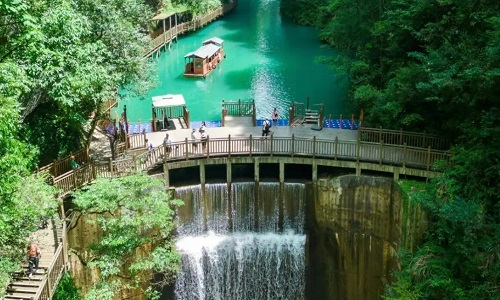
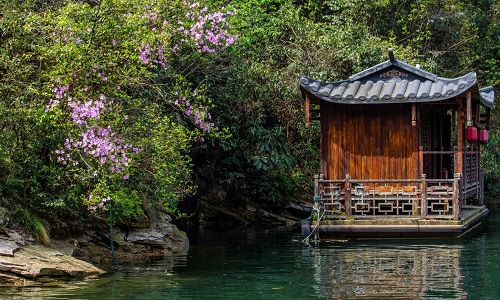
1. Spring (March-May): Ethereal Mist & Ink-Wash Landscapes
Key Shots: "Chinese Painting" Vibe
Misty Peaks at Dawn – After light rain, the valleys fill with low-hanging clouds, creating a dreamy, ink-wash painting effect.
Soft Light & Pastel Tones – Overcast days enhance the delicate greens of new foliage.
Waterfalls in Bloom – Spring rains swell streams, making Baofeng Lake & Golden Whip Stream ideal for silky water shots (use ND filter + tripod).
Best Locations:
Yuanjiajie (Avatar Mountains) – Mist clings to the pillars like cotton.
Tianzi Mountain – Clouds drift between peaks like a living scroll painting.
Challenge: Unpredictable rain—pack waterproof gear!
2. Summer (June-August): Starry Skies & Emerald Forests
Key Shots: Galactic Peaks & Deep Greens
Milky Way Over Stone Pillars – In July-August, the galactic core aligns perfectly with the peaks. Use a wide-angle lens (14-24mm) + high ISO (3200+).
Backlit Peaks at Sunset – Shoot silhouettes of pinnacles against golden light.
Lush Jungle Details – Macro shots of ferns, vines, and waterfalls in Zhangjiajie Grand Canyon.
Best Locations:
Yangjiajie – Remote & dark, perfect for astrophotography.
Glass Bridge at Night – Light trails from passing drones create surreal effects.
Pro Tip: Avoid midday—harsh shadows flatten textures.
3. Autumn (September-November): Fire & Fog
Key Shots: Layers of Mist & Crimson Foliage
Peaks Piercing Autumn Fog – At sunrise, cold air creates horizontal mist bands between the pillars.
Red Maple Contrast – Late October brings fiery leaves—frame them against gray stone pillars.
Harvest Culture – Capture Tujia farmers drying corn on wooden racks.
Best Locations:
Golden Whip Stream – Maple trees line the water.
Yellow Stone Village – Elevated views of color-washed valleys.
Prime Time: Mid-October to early November for peak foliage.
4. Winter (December-February): Snow-Capped Minimalism
Key Shots: Black & White Majesty
Snow-Dusted Peaks – After a snowfall, the pillars become monochrome sculptures. Use high contrast B&W processing.
Frozen Waterfalls – Baofeng Lake’s cascades turn into icy stalactites.
Solitary Trees – Leafless branches add graphic elements to compositions.
Best Locations:
Tianmen Mountain – The "Heaven’s Gate" arch framed by snow is iconic.
Ten-Mile Natural Gallery – Snow highlights the ridges like pencil sketches.
Gear Warning: Batteries drain fast—bring spares and hand warmers!
Special Weather Phenomena: Chase the Magic
Cloud Waterfalls (After Heavy Rain)
When: Summer thunderstorms or spring drizzle.
Where: Yuanjiajie’s deeper valleys—clouds pour like waterfalls.
How to Shoot: Use fast shutter (1/500s) to freeze motion or long exposure (2-5s) for a silky flow.
Sea of Clouds (Pingliu Fog)
Forecasting: Check humidity >90% + light wind the night before.
Best Time: Sunrise—when cold air traps fog in valleys.
Pro Trick: Shoot from higher elevations (Tianzi Mountain) looking down.
Rainbows Across Peaks
When: Late afternoon showers + sudden sun.
Hotspot: Golden Whip Stream’s open areas.
Composition: Use a polarizing filter to intensify colors.
Zhangjiajie’s weather shifts hourly. Pack:
Rain cover for gear
Lens cloths (humidity causes fogging)
Portable charger (cold drains batteries)
Creative Photography Techniques: Beyond the Ordinary
Zhangjiajie’s surreal landscape is a playground for experimental photography. If you want to move beyond postcard shots and create truly unique images, try these advanced techniques that transform the peaks into otherworldly art.
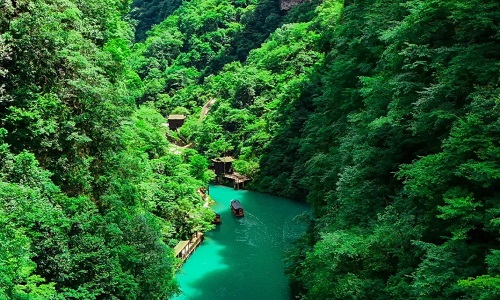
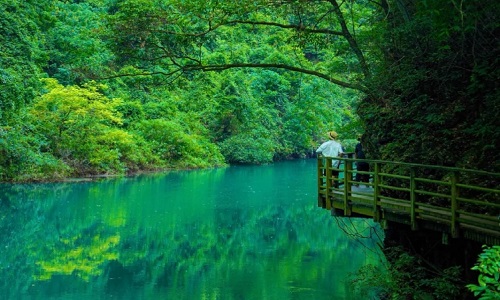
Breakthrough Composition Experiments
1. Cable Car as a Framing Device
Why it works: The glass windows of Zhangjiajie’s cable cars create a natural frame, adding depth and storytelling to your shots.
How to shoot it:
Position yourself near the rear of the cabin to avoid reflections.
Shoot through the window at an angle to capture both the interior (as a frame) and the exterior peaks.
Best time: Sunrise or sunset when warm light hits the mountains.
Pro tip: Use a polarizing filter to reduce glare on the glass.
2. Reflections in Rain Puddles
Why it works: After rain, temporary puddles on trails or viewing platforms create mirror-like illusions of the peaks.
How to shoot it:
Get low—place your camera just inches above the water.
Use a wide-angle lens (16-35mm) to exaggerate the reflection.
Shoot at golden hour for warm, glowing reflections.
Pro tip: Carry a small spray bottle to enhance small puddles if needed.
3. Infrared Photography: An Alien World
Why it works: Infrared (IR) photography turns foliage white and skies dark, making Zhangjiajie look like an alien planet.
How to shoot it:
Use an IR-converted camera or an IR filter (like Hoya R72).
Best conditions: Bright midday sun with lush greenery.
Post-processing: Swap color channels for surreal blue or golden tones.
Pro tip: Shoot in RAW for maximum editing flexibility.
Combining Portraits & Landscapes
1. Miao Minority Costumes Against Stone Peaks
Why it works: The vibrant embroidered outfits of Miao women create a stunning contrast with the rugged stone pillars.
How to shoot it:
Hire a local model (available near Tianzi Mountain).
Pose them on a cliff edge or winding path for scale.
Use backlighting to make the silver headdresses glow.
Pro tip: Shoot at f/2.8–f/4 to blur the background slightly.
2. Thrilling Glass Walkway Shots
Why it works: The Zhangjiajie Grand Canyon Glass Bridge adds drama and vertigo-inducing perspectives.
How to shoot it:
Lie flat on the glass and shoot straight down (wide-angle).
Capture reactions—have your subject "fall" or balance precariously.
Long exposure (2-5 sec) to blur moving clouds above.
Warning: Secure your camera strap—no drops allowed!
3. Light Painting & Star Trails at Night
Why it works: Zhangjiajie’s low light pollution allows for celestial photography.
How to shoot it:
Star trails: 30+ minute exposure (use interval mode).
Light painting: Use LED sticks to "draw" around the peaks.
Best spot: Remote areas of Yuanjiajie after park closure.
Pro tip: Scout locations in daylight first—safety first in the dark!
Gear Recommendations for Creative Shots
IR Camera: Converted DSLR or mirrorless.
Fast Lens: f/1.4–f/2.8 for portraits.
LED Light Stick: For night experiments.
Final Thought: Zhangjiajie rewards those who think outside the frame. Push your creativity, and you’ll leave with images nobody else has.
Post-Processing Masterclass: Enhancing Zhangjiajie's Magic
Zhangjiajie’s surreal landscapes demand equally creative editing. Whether you’re aiming for hyper-realistic drama or ethereal fantasy, these advanced techniques will make your shots stand out.
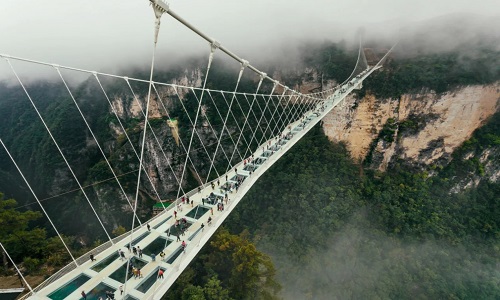
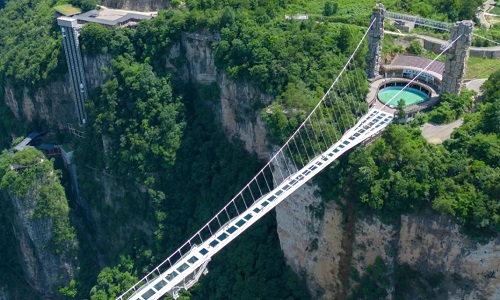
Zhangjiajie-Specific Presets & Styles
1. Enhancing Sandstone Texture
Make every crevice and ridge pop:
Local Adjustments (Lightroom/Photoshop):
Use the Brush Tool (+Clarity/Texture) to selectively sharpen peaks.
Apply Dehaze (lightly) to cut through mist without losing atmosphere.
Frequency Separation (Photoshop):
Separate texture from color to sharpen rock details without affecting shadows.
2. Chinese Ink Painting Style
Recreate traditional shan shui aesthetics:
Color Grading:
Shift greens toward teal (HSL: Hue +15, Saturation -10).
Mute reds/oranges for a monochromatic vibe.
Tonal Contrast:
Soften midtones (Curves: gentle S-shape) while preserving highlight/shadow depth.
3. Avatar-Inspired Blue-Purple Tones
Channel Pandora’s otherworldly glow:
Split Toning:
Highlights: Cyan (220°) / Shadows: Magenta (300°).
Luminosity Masks (Photoshop):
Paint blue hues onto misty areas using Low Opacity (20-30%) brushes.
Panorama Stitching Solutions
1. Fixing Cloud Movement Seams
When mist ruins your stitch, Manual Blending (Photoshop):
Layer masks + Clone Stamp to align drifting clouds.
PTGui Pro Trick:
Enable "Horizon Correction" and "Blend Priority" for smoother transitions.
2. Ultra-Wide Angle Distortion Fixes
Correct bent peaks from 12-16mm lenses:
Lens Profile Corrections (Lightroom):
Enable "Remove Chromatic Aberration" + "Profile Corrections".
Guided Vertical/Horizontal Lines (Photoshop > Adaptive Wide Angle):
Force towering peaks to align vertically.
3. Natural HDR Blending
Avoid the "plastic" look:
Bracketing Tips:
Shoot 3-5 exposures (1-stop intervals) with a tripod.
Luminosity Masking (Photoshop):
Blend skies from underexposed frames and foreground from brighter ones.
Workflow Pro Tips
Non-Destructive Editing: Always use Smart Objects in Photoshop for flexibility.
Batch Processing: Create Lightroom Presets for consistent style across a series.
Sharpening Order: Apply local sharpening last to avoid amplifying noise.
Final Thought: Zhangjiajie’s landscapes are half-captured in camera, half-created in post. Whether you prefer realism or fantasy, these techniques will help your images match the park’s natural grandeur.
Practical Photography Travel Tips
Smart Itinerary Planning
1. Early Morning "Avoid the Crowds" Route
Zhangjiajie’s most famous spots (like Yuanjiajie and Tianzi Mountain) get packed by 9 AM. To shoot in peace:
4:30 AM – Start at Yangjiajie (quieter than Yuanjiajie) for sunrise.
6:00 AM – Move to Avatar Hallelujah Mountain before tour buses arrive.
7:30 AM – Head to Golden Whip Stream while others are still at breakfast.
Pro Tip: Stay overnight inside the park at Zhangjiajie Village to access viewpoints before day-trippers.
2. Lightweight Gear Strategy
Hiking between viewpoints involves thousands of stairs. Pack smart:
Essentials Only: Mirrorless camera + 2 lenses (wide + telephoto).
Carbon Fiber Tripod – Lighter than aluminum.
Peak Design Clip – Keeps your camera accessible without a neck strain.
Waterproof Backpack – Sudden rain showers are common.
3. Best Lodging for Sunrise Shoots
Inside the Park:
Zhangjiajie Youth Hostel – Budget-friendly, 10-min walk to viewpoints.
Pipaxi Hotel – Mid-range, near Tianzi Mountain cable car.
Outside the Park (Better Amenities):
Pullman Zhangjiajie – Luxury option with early shuttle service.
Key Distance Reference: From Wulingyuan entrance to Yuanjiajie = 1.5 hours (shuttle + cable car).
Local Guide Services
1. Tujia Photographer Guides
Hiring a local photographer guide (¥500-800/day) gives you:
Secret vantage points (e.g., unmarked cliff edges for unobstructed views).
Golden-hour timing expertise based on weather patterns.
Cultural insights – Many guides are ethnic Tujia minorities who know hidden village photo ops.
Recommended: Mr. Li (WeChat: ZJJ_PhotoGuide), a former park ranger turned pro photographer.
2. Safety at Risky Angles
Some epic shots require off-trail scrambling. Guides help with:
Steep terrain navigation – Loose rocks are common.
Weather alerts – Sudden fog can make trails disappear.
Cable car schedules – Missing the last ride down means a 5-hour hike.
Warning: No guardrails at unofficial viewpoints—never shoot alone.
3. Booking Minority Models
For portraits with Tujia culture elements:
Traditional Costumes: Red and silver headdresses (¥100-200/hour rental).
Village Settings: Shoot at Suoxi Valley or Tianmen Mountain’s temple.
Best Time: Harvest season (Sept-Oct) when locals wear festive attire.
Contact: Zhangjiajie Photography Association arranges authentic models (WeChat: ZJJPA_Models).
Why These Tips Matter
Zhangjiajie rewards early risers and prepared photographers. With the right:
Timing (beat the crowds),
Gear (travel light, shoot smart),
Local help (guides = safety + secret spots)
Photography Ethics & Conservation in Zhangjiajie
Zhangjiajie’s surreal landscapes are fragile. As photographers, we have a responsibility to protect its ecosystems while capturing its beauty. Here’s how to shoot ethically and legally in this UNESCO World Heritage Site.
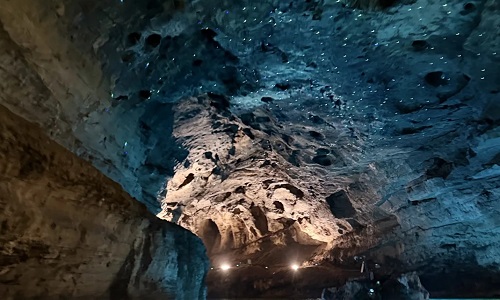
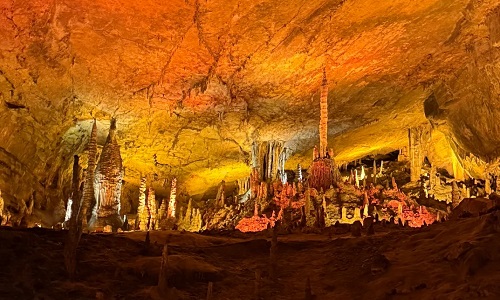
Eco-Conscious Photography Guidelines
1. Protected Area Restrictions
What NOT to Do:
No off-trail hiking – Straying damages delicate moss and plant life.
No flying drones in banned zones (e.g., near wildlife habitats). Check park maps.
No removing rocks/plants as "souvenirs" for photos.
Sustainable Alternatives:
Use long lenses (100-400mm) to photograph rare flora without touching.
Stick to boardwalks and marked trails to prevent soil erosion.
2. Wildlife Photography Ethics
How to Shoot Animals Responsibly:
Keep distance – Use a telephoto lens; never bait macaques with food.
Avoid flash – Startles birds and nocturnal creatures.
Silent mode – Disable shutter sounds to minimize disturbance.
Local Insight: The golden snub-nosed monkey is endangered. If spotted, observe quietly—no chasing for shots.
3. Sustainable Photography Practices
Leave No Trace Principles for Photographers:
Carry out all trash (including used lens wipes).
Avoid geotagging exact locations of rare species to prevent overcrowding.
Support eco-tours that fund conservation (e.g., park-sanctioned guides).
Copyright & Legal Considerations
1. Commercial Shoot Permits
When You Need Authorization:
Paid photo shoots (e.g., weddings, fashion).
Drone footage for profit (requires a permit from the Zhangjiajie National Forest Park Administration).
Process: Apply via the park’s official website 2+ weeks in advance. Fees vary by project scope.
2. Social Media Best Practices
Giving Proper Credit:
Tag locations generally (e.g., "Zhangjiajie National Park" vs. GPS coordinates).
Credit indigenous culture respectfully (e.g., "Tujia minority village, Hunan").
Avoid misleading edits (e.g., exaggerated colors that misrepresent the landscape).
3. Photography Contest Submissions
Competition Guidelines:
Verify rules on AI/editing limits (many ban composite images).
Include model releases if faces are visible.
Cite exact locations if required (e.g., "Shot at Tianzi Mountain Viewing Platform").
Pro Tip: The "Zhangjiajie International Photography Festival" (held biannually) has strict authenticity checks.
Why This Matters
Zhangjiajie’s magic exists because generations protected it. By following these practices, you ensure:
Wildlife thrives without human interference.
Local communities benefit from respectful tourism.
Future photographers experience the same untouched beauty.
Photography Gear & Support Stations: Be Prepared for Zhangjiajie
Zhangjiajie’s dramatic landscapes demand specialized gear and preparation. Whether you’re a professional photographer or an enthusiastic traveler, here’s everything you need to know about equipment rental, emergency repairs, and weatherproofing in the park.
Camera Gear Rental & Support Services
1. Professional Equipment Rental Shops
Where to Rent High-End Gear Near the Park
Zhangjiajie City Center – Several shops near Wulingyuan Gate offer:
Full-frame DSLRs & mirrorless cameras (Sony A7R, Canon 5D)
Lenses (16-35mm wide-angle, 70-200mm telephoto)
Drones (DJI Mavic 3, but check local regulations)
Tripods & gimbals (Manfrotto, DJI RS3)
Cost: ~$30–$100/day (deposit required).
Tip: Book in advance during peak seasons (May–Oct).
2. Emergency Repair Workshops
Where to Fix Gear in a Pinch
Wulingyuan Camera Clinic (Near the park entrance)
Quick sensor cleaning
Lens calibration
Minor water damage repairs
Zhangjiajie City Camera Hospital (For major issues)
Warning: Bring spare batteries—power outlets are scarce in the mountains.
3. Memory Card Backup Services
Avoid Losing Precious Shots
Photo backup kiosks at major hotels & visitor centers (~$5/backup).
Portable SSD rentals (Samsung T7, LaCie Rugged).
Cloud uploads (if you have mobile data).
Pro Tip: Carry multiple 128GB+ cards—shooting RAW in misty conditions eats storage.
Extreme Weather Protection
1. Anti-Humidity & Anti-Fog Gear
Zhangjiajie is 80%+ humidity year-round—protect your equipment!
Silica gel packs (throw them in your bag).
Lens anti-fog cloths & sprays (Zeiss wipes work well).
Rain sleeve for cameras (or DIY with a plastic bag + rubber band).
Waterproof backpack (like Peak Design’s Travel Backpack).
2. Rainy Season Photography Plan
Shooting in the Rain? Here’s How:
Best Locations: Golden Whip Stream (moody water reflections).
Gear Setup:
Weather-sealed camera (e.g., Nikon D850, Sony A7 IV).
Lens hood (to block raindrops).
Microfiber towels (for quick wipes).
Creative Shots: Slow shutter (1/4 sec) for silky waterfalls.
3. High-Altitude Shooting Tips
Some peaks exceed 1,200m (4,000 ft)—prepare accordingly!
Battery Performance: Cold drains power—keep spares warm in your pocket.
UV Filters: Reduces haze at high elevations.
Oxygen Canisters: Sold at park gates (for altitude sickness).
Layered Clothing: Mornings are freezing; afternoons get hot.
Pro Move: Use gloves with touchscreen fingertips for adjusting settings.
Final Checklist Before You Go
Rent/backup gear in Wulingyuan if needed.
Pack weather protection (rain sleeves, silica gel).
Charge 3x batteries (cold + long shoots drain them fast).
Download offline maps (cell service is spotty).
Explore Your Way Holiday’s Best Recommended Tours.
We design private and Tailor-made Zhangjiajie Tours customized to your style of travel at affordable local prices. We will provide a private & spacious car and a local professional tour guide with over 5 years guiding experience only work for you or your group. Transport, ticket, and dining (We find the most authentic dishes popular with locals) all we will arrange for you according your requirements. Please check our most popular tours below:
Are the above sample tour programs not suitable for you? Dont worry, our Zhangjiajie Tour Can Be Tailor-made based on your requirements and budget to create unique Beijing experiences that allow you to interact with the local people and culture. We are Beijing travel experts who know what your guidebook and foreign agencies don't. Our enthusiastic tour expert will promptly reply you in details within 24 hours.
Wechat: Chinaprivatetour
24 Hours Hotline:
+8613735411378
1 to 1 tailor-made service from our professional travel advisors for the most sophisticated
Constantly excellent reviews for attraction, hotel and service Competitive price
Local experts provide quality tours Best selected knowledgeable local guides Authentic local restaurants
7*24 hours available to create you a worry-free tour. No Hidden Fees and absolutely no pressure to buy. Secured







